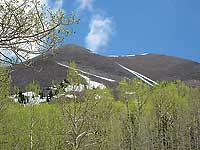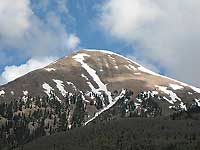 When our even-tempered spring gives way to another heat-generating summer, the tantalizing vision of the La Sal Mountains is a tempting sight. As the melting pot down here bubbles along, my desire increases for an alpine hike up there. My yearning, however, for that uplifting coolness must be put on hold while we wait for the big thaw as we keep wondering how long that will take. When our even-tempered spring gives way to another heat-generating summer, the tantalizing vision of the La Sal Mountains is a tempting sight. As the melting pot down here bubbles along, my desire increases for an alpine hike up there. My yearning, however, for that uplifting coolness must be put on hold while we wait for the big thaw as we keep wondering how long that will take.
In early June my husband and I decide to see if the drive to the La Sal Pass trailhead is possible. A dryer, warmer spring has given us the sooner-rather-than-later chance to try this. The odds, however, are still against us for covering the whole distance before a blockage of snow brings us to a halt. To our amazement we only encounter one small patch of snow, which we easily plow through. When we arrive at an elevation that is over 10,000 feet, we pull in and park at the pass. That was the first surprise of the day.
Stepping out of our pick-up the next big surprise awaits us - the vibrating chorus of dozens and dozens of frogs. Their “creeek” calls sound like a finger dragging across a comb, and I am astounded as I ask, “How can there be frogs at this altitude?” 
I have since learned that boreal chorus frogs know what it takes to survive their extreme environment. Before winter sets in these freeze-tolerant amphibians bury themselves in the mud and hibernate. When the ice and snow melts off their small pond, they come to life. Now during their short summer of opportunity, the race is on to produce another generation of frogs.
When approached these wary, one-inch long songsters submerge in the water like a submarine. Only when the coast is clear will they pop back up to the surface. Anxious to return to full throttle they immediately pour all their energies in to their looking-for-a-mate music.
My husband heads off to climb several peaks while I start walking down through a meadow on one of my favorites - the Burlfriends trail. Covering a distance of over four-miles, it ends farther down on the La Sal Pass Road. Burlfriends seems like an odd name until you realize it refers to all the burls (the knotted wood) found on the older aspens. Even at this elevation the sun can be intense, and I crave that shady canopy with its enchanting waltz of the aspen leaves.
This early in the season, most of the alpine flowers (except for dandelions and clover) are yet to bloom. I know snowdrifts will undoubtedly cover parts of the trail, but the good news is I am way ahead of the mosquitoes! Thunderheads are building so I’m not sure which will stop me first: rain or a huge snow bank.
 This meadow offers a perfect view of two familiar peaks: Mt.Tukuhnikivatz, also known as Tuk, and Mt. Peale. At 12,482 feet, the distinctively shaped peak of Tuk is the third highest in the La Sals, and legend suggests that Tukuhnikivatz is a combination of Native American words that mean, where the sun lingers longest. To the right of Tuk, Mt. Peale, our highest peak, has an elevation of 12,721 feet. In 1875, it was named after Albert Charles Peale, a geologist on the Hayden Survey team. This meadow offers a perfect view of two familiar peaks: Mt.Tukuhnikivatz, also known as Tuk, and Mt. Peale. At 12,482 feet, the distinctively shaped peak of Tuk is the third highest in the La Sals, and legend suggests that Tukuhnikivatz is a combination of Native American words that mean, where the sun lingers longest. To the right of Tuk, Mt. Peale, our highest peak, has an elevation of 12,721 feet. In 1875, it was named after Albert Charles Peale, a geologist on the Hayden Survey team.
After a half-mile there’s a signed junction. Instead of taking the steep Tuk Trail No. 093, which goes up to the ridge of Tuk, I opt to go right to stay on the Burlfriends. Now traveling through the thickness of deep woods I relish the pungent scent of pine and the trickling flow of a small stream. Before long, however, portions of the trail disappear as I start post holing through softened drifts of snow.
Despite the lack of flowers and the abundance of snow, as the day warms up the butterflies come to life and frolic around. Their elegance and bright colors add a special touch to this early summer outing. 
As always, I tune in to the orchestrated voices of birds: the chipping sparrow’s buzzy twill, the boisterous, jumbled voice of the ruby-crowned kinglet, and the red-breasted nuthatch’s tinny, “yank-yank” call. Flitting from tree to tree, energetic robins sing their melodious tune. Then I hear a memorable melody that I always associate with the earthy secrets of heavily forested places – the haunting, flute-like tune of the Hermit thrush.
A wooden bridge crosses a frisky stream, and immediately after that I walk over a remote road that dead-ends a short distance away. Now glancing up through the leafing out aspens, I catch another powerful glimpse of Mt. Peale and the gathering collection of frowning, black clouds - a reminder of how fickle and fast changing mountain weather can be.
At Beaver Lake the unexpected happens as I stumble upon three bull elk in various stages of velvet. Although common in the La Sals, these majestic animals are shy and elusive. During the day they usually hunker down in deeply wooded areas, not coming out to graze until dusk. Consequently I am surprised at how unwary this bachelor threesome is. At my approach they continue munching their way in and out of their marshy pond. Every now and then, one of them lifts his head and quizzically stares at me as if to ask, “Are you still here?” This peaceful connection lasts a long time until they leisurely wander out of sight. 
Just beyond the lake the humungous amount of lingering, blockbuster snow piled within the dark shadows of the firs and spruce clinches it for me. This is definitely as far as I’m willing to go! I’ve been lucky to cover 1.5 miles and for now, that’s good enough, especially since I need to save some energy for my snow-riddled, uphill journey back to our truck.
To access the La Sal Pass trailhead drive south from Moab on Highway 191 approximately 22 miles and turn left at the sign for the town of La Sal on to Highway 46. Then drive another 13 miles and take a left on to the Upper Two Mile graveled dirt road. In two more miles make another left turn for the La Sal Pass Road and drive six more miles to the La Sal Pass parking area. This graveled road to the pass with one stream crossing (a total of nine miles) is suitable for most two-wheel-drive vehicles. At the pass the road changes to four-wheel-drive and continues down to Pack Creek Ranch.
|